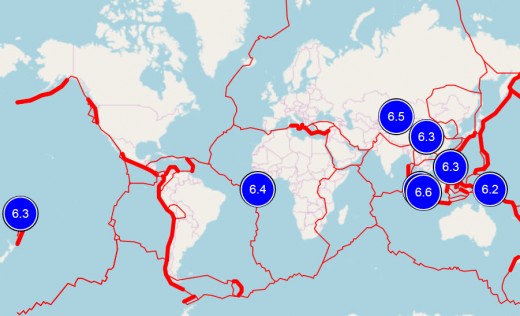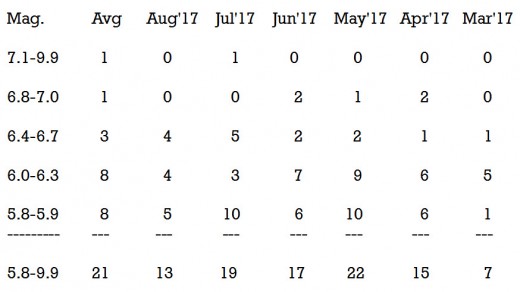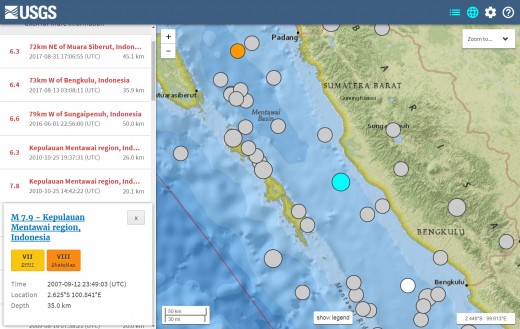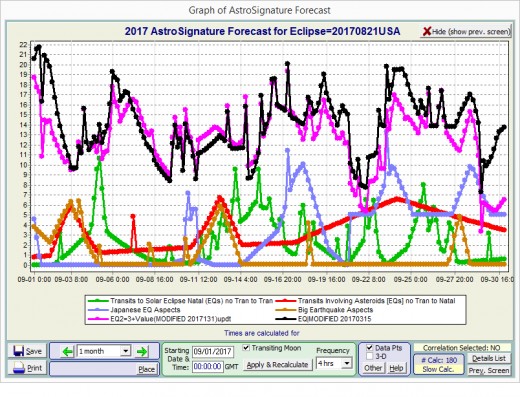Seismic Review and Forecast for September 2017


Of Storms, Earthquakes, and Eclipses
Seismic events that I attempt to forecast each month are primarily those of at least 6.75 in magnitude (in Mw), and I label such events as significant. August 2017 did not see any such events. The big news of course was the storm that hit the Houston, Texas area. Hurricane Harvey came ashore on the night of the 25th of August as a category 4 storm. It is possible, just as they can be tied to earthquake activity, that the last total solar eclipse had something to do with it.
Back in the year 1999, there was a total solar eclipse that passed through Europe in August of that year. Days later there was a deadly earthquake in Turkey, which killed many thousands of people, and 3.5 months later there was an historic windstorm which did great damage in Europe, especially in France where 10,000 trees were destroyed in the Paris area, and one quarter of that country's high tension electrical lines were brought down by the winds. That storm killed 140 people and caused 14 billion in damage (in USD).
The present biblical storm which ravaged Texas is likely to cause a similar amount of lives and dollars lost. It is this researcher's conclusion that this last eclipse is a deadly one and that it is likely to be the harbinger of at least one and as many as three significant earthquakes inside the continental United States or the Caribbean within the coming months and years (key times being 3-4 months, 1.3-1.7 years, and 3.3-4.1 years from now).
But this is getting ahead of myself. Let us look at the past month and the month to come.

Seismic Review of August 2017
The only thing seismic that was not below normal last month was the fact that there were four earthquakes within the range of 6.4-6.7 in magnitude (when average is three per month). When it came to the real energetic quakes, or the significant ones of at least 6.75 in magnitude, they were absent (when average is two per month). The activity for August (for earthquakes of at least 5.8 in magnitude) was so low that it turned out to be not much more than half of normal.
So, one might ask, is it going to stay slow for awhile or is this what is known as the calm before a series of major events in the form of a seismic storm? That is a good question, and I am not sure if September will hold the answer. But again, I am getting ahead of myself. Back to a review of August.
Actually the story of August has its roots in a period more than a half year ago. There was more than average seismic activity worldwide in a period from the 13th of November of 2016 to the 22nd of January 2017. But then, things slowed down for a very long time. Activity was anywhere from below average to average from February 2017 through August. And the largest quakes (of at least 7.1 in magnitude) were absent for almost half of a year before one of 7.7 in magnitude occurred on the 17th of July 2017.
I thought that things might speed up after that but, if there was a pick up in activity, it only lasted three days. Things returned to what has been normal lately, or average worldwide activity at best. Of course, this is very upsetting to someone such as myself, since my research shows that it is usually at these very times that astrology gets pushed into the background and randomness comes to the fore.
However, it is my belief that there will not be long to wait. I'll get to that in a little bit, for now let's return to August 2017.
In last months forecast, I posted a day or two past my deadline (usually it is done within hours of the beginning of the month) because I was convinced that nothing seismically major would occur during the first week of August 2017. It turned out that I was right about that. However, not much more than one half of a day after that period, something noteworthy occurred. Or should I say began to occur—one earthquake of 6.5 in magnitude, one of three quakes tied for second place (when normally there would be three or four bigger quakes in a month) occurred not far from the far western border. Twenty-five people died in that temblor (twenty-one times more were injured). For the most part, the magnitudes of the earthquakes given in this article are gleaned from the source used to construct the table above (and not the map at the start of the article).
With the exception of three quakes varying from 4.0 to 6.0 in magnitude, each one causing one or two deaths (happening 4, and then 13-14 days later) there were no other casualties that month. But the months oddity happened about ten hours later, when a 6.3 magnitude earthquake occurred, this time in the eastern region of China, causing 32 injuries (the source of information for this paragraph is James Daniell's CATDAT).
The second of three quakes tied in strength with the first China quake mentioned above occurred on the western coast of Sumatra on the 13th of August. This quake was deep enough (55 km or 34 miles) and in the upper range of moderate, that it did not cause any death, injuries, or major damage. It was significant in my opinion however because of a similar sized quake (M6.3) which occurred on the last day of August, 234 miles or 378 km NNW of the earlier shock. These could represent foreshocks located at either end of a potential fault rupture for an earthquake of over 8.0 in magnitude.

There was a magnitude 7.9 event between those two quakes on 12 September 2007 and a 7.8 magnitude temblor on 25 October 2010. A more energetic quake may be in the offing in that general area in the near future. A total solar eclipse also passed through that area on 9 March 2016. In my research it has been often seen that very large quakes follow eclipses around 1.5 years after the eclipse and near the shadow path of the eclipse (often within a few hundred miles).
Before moving on to the forecast for September 2017, let us see how I did for the month of August based on my last forecast.
Since, what I normally try to predict are earthquakes of at least 6.75 in magnitude and there were no such seismic events in the month, the bar would need to be lowered to say 6.3 in magnitude. The two China quakes on the 8th of the month was on the first day of my first seismic window. The event on the 13th off the coast of Sumatra also happened within the same window. That first window was 8 days in length, so it is not too surprising that two of the top three earthquakes in magnitude occurred within that window.
The next window was only two days in length and the largest quake, a magnitude 6.6 event in the mid Atlantic, occurred just 3 hours after my second window closed. When that happened, I felt that I must have missed the mark due to rounding too much. Looking more closely at the data confirmed that and I posted a comment at the bottom of my article that day saying as much and adding that another quake of similar size may result somewhere else in the world by the end of the day or within the early part of the next day (in Universal Time). At 0200 UT the next day, there was a very deep and harmless magnitude 6.5 earthquake near the island of Fiji (this was the third of three quakes in the second biggest event category).
My last window was originally forecast to be from the 27th through the 30th of August. Six days before the end of the month, I posted a comment to my last article stating that the window should extend to the end of the month. There were two events of 6.3 magnitude within that last window (one on the first day and one on the last). The first of these was in the Admiralty Islands of Papua New Guinea. Originally I thought that this was an aftershock to one of the large events (7.8-7.9 magnitude earthquakes) which occurred in the same general area 8-9 months prior, but I now feel that its location is outside the range for it to have been directly related to any one of them.

Seismic Forecast for the Month of September 2017
The first week of September could very well turn out to be the flip side of August. In other words, if the first week of August was nothing, the first week of September should be something. This is particularly true for the first two days of that week and the last three. They also relate to that west coast region of Sumatra where two mid 6 quakes occurred in August on the 13th and 31st. If nothing happens in that location, look for possible activity in Japan or Turkey during the first two days of that window or in the continental U.S. or the Caribbean for the last three days of that window.
The next strong possible date is the 13th of September, again looking at the U.S. or the Caribbean as contenders, but the most likely dates after the first week are on the 17th or 18th and 23 and 24th of September. The best bet for a location for all of those dates would center on Japan, but it could also be in Chile or the U.S. (not excluding Alaska). My feeling is that both these last four dates and the five mentioned out of the first week of the month will produce earthquakes at 80% above the monthly average. In other words, there should be a 108% chance that there will be one 6.75 magnitude earthquake or larger some where in the world during those 9 days rather than the usual 60% chance. I am betting that there will be two such quakes during that period and one more on such dates as the 19th, 25th, or 28th of September (or very close to those dates in Universal Time).
Although the continental U.S. and/or the Caribbean is mentioned above as possible locations on some of the seismic window dates there given, more likely times exist during the months of November and December of 2017, but especially during the first five to six months of 2019.
This article is accurate and true to the best of the author’s knowledge. Content is for informational or entertainment purposes only and does not substitute for personal counsel or professional advice in business, financial, legal, or technical matters.
© 2017 Joseph Ritrovato








